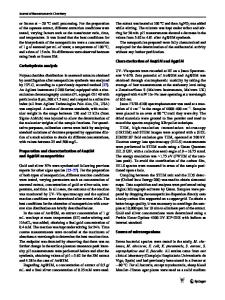Novel synthesis of polycationic gold nanoparticles and their potential for microbial optical sensing
- PDF / 1,728,782 Bytes
- 6 Pages / 595.276 x 790.866 pts Page_size
- 44 Downloads / 377 Views
ORIGINAL PAPER
Novel synthesis of polycationic gold nanoparticles and their potential for microbial optical sensing Ravichandran Manisekaran 1 Luz M. López-Marín 1
&
Edgar Jiménez-Cervantes Amieva 1
&
Carlos M. Valdemar-Aguilar 1
&
Received: 27 April 2020 / Accepted: 6 October 2020 # Springer Nature Switzerland AG 2020
Abstract The aim of this research was to describe a facile protocol to obtain biocompatible gold nanoparticles (AuNPs) suitable for microbial optical sensing. For this purpose, polycationic poly-L-lysine (PLL) was employed as both reducing and stabilizing agent in order to obtain an optically active microbial nanotag based on the electrostatic interaction with negatively charged cell envelopes. A one-pot procedure was developed to produce homogeneous, positively charged AuNPs. The as-synthesized particles, named PLL@AuNPs, exhibited maximal surface plasmon resonance (SPR) at 532 nm, a FCC crystalline nature, and sizes ranging from 20 to 25 nm, according to spectroscopy, X-ray diffractometry (XRD), transmission electron microscopy (TEM), and dynamic light scattering (DLS) analyses. The reduction of gold ions by PLL was featured by Fourier-transform infrared (FTIR) absorption bands of various functional groups. Zeta potential analysis confirmed the high cationic feature with a value of + 57 mV. The applicability of the particles to tag bacterial cell surfaces was exemplified by their adherence to Escherichia coli, a bacterial species commonly used to monitor fecal pollution in water sources. Finally, the potential of this tagging approach for microbial sensing through surface-enhanced Raman scattering (SERS) was explored. Keywords Gold nanoparticles . Bacterial nanotag . Poly-L-lysine . Peptide-mediated reduction . SERS
Introduction Gold nanoparticles (AuNPs) represent one of the most promising materials for microbial sensing and diagnostics, mainly due to their unique optical properties [1]. A variety of methods have been proposed for the decoration of AuNPs for tagging microorganisms based on both chemical linkage or physical adsorption of specific ligands, including antibodies, oligonucleotides, aptamers, or phage-displayed polypeptides [2–5]. Nevertheless, there has been an emergence for the screening of microorganisms in different environments, and the availability of low-cost, functional AuNPs of broader applicability would be beneficial. Given the high negative charge of microbial cell surfaces, the use of electrostatic interactions to unspecifically tag microbial cells seems appealing. The use
* Luz M. López-Marín [email protected] 1
Centro de Física Aplicada y Tecnología Avanzada, Universidad Nacional Autónoma de México, Boulevard Universitario 3001, UNAM Campus Juriquilla, 76230 Querétaro, México
of poly-L-lysine (PLL), a highly biocompatible, cationic polypeptide of natural origin [6], constitutes an attractive alternative to obtain cationized AuNPs. Incidentally, in recent years, various peptide molecules, including PLL, have been reported to act as reducing agents during the synthes
Data Loading...











